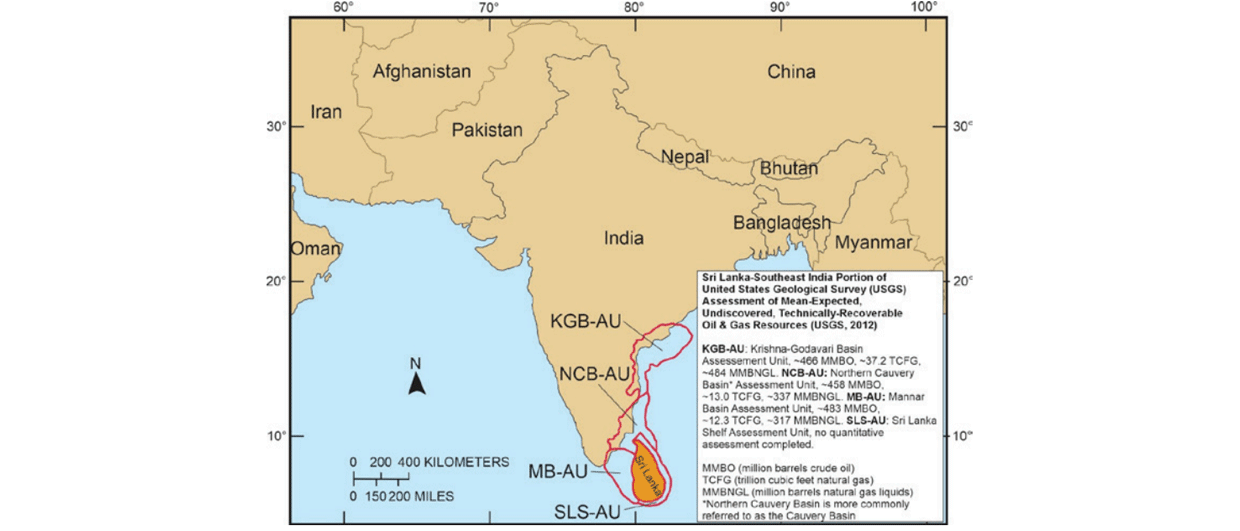ter a successful track record of petroleum exploration in the Barmer Basin in the Indian state of Rajasthan (see GEO ExPro, Vol. 8, No. 6), Cairn India has expanded its activities to Sri Lanka. Cairn Lanka, a subsidiary of Cairn India, has struck gas in the offshore Gulf of Mannar Basin between Sri Lanka and the southern tip of peninsular India. As operator, Cairn Lanka holds 100% participating interest in the block.
Cairn’s discovery comes after three decades of hiatus in the oil exploration of this small island country. Sri Lanka (previously called Ceylon) has a land area of 64,630 km2 with a coastline of 1,340 km; the country is mainly made up of Precambrian granites and metamorphic rocks, and only 15% of the island, notably its northern corner close to India, is covered by sediments. This area, extending across the Palk Strait, is geologically part of the larger Cauvery Basin, which contains Cretaceous-Quaternary sedimentary rocks. Indeed, only these Cauvery Basin sediments had drawn the attention of petroleum explorers in the past, with wells that included Pesalai 1, 2 and 3 undertaken by Soviet oilmen in 1974, Palk Bay-1 and Delft-1 drilled by Marathon in 1976, and Pedro-1 and Pearl-1 drilled by Cities Services in 1981. None of these wells proved successful, although Pesalai-1 drilled on the island of Manar to a depth of 2,594m encountered some gas in Lower Cretaceous sandstone, and Pearl-1 drilled in the northern part of Sri Lanka’s Gulf of Mannar to a total depth of 3,050m bottomed in a volcanic sill after penetrating an 850m-thick Upper Cretaceous sandstone.
Two Discoveries
In 2002 and 2005, Norwegian contractor TGS NOPEC acquired 2D seismic data in Sri Lanka’s Mannar Basin, to the west of the island. Based on their encouraging report, in 2007 the government of Sri Lanka divided the basin into nine exploration blocks and offered three of them for bids from international oil companies. On 7 July 2008, Sri Lanka’s Ministry of Petroleum and Petroleum Resources Development Secretariat awarded to Cairn Lanka Block SL2007-01-001, with an area of 3,340 km2 in water depths from 400 to 1,900m. The period of licensing runs until October 2016. In December 2009, Cairn conducted a 3D survey in its exploration block, and went on to drill its first well in August 2011.
Cairn has reported two discoveries from its block. In October 2011, the company announced that its exploratory well CLPL-Dorado-91H/1z, drilled some 30 km from the Sri Lankan coast in a water depth of 1,354m, encountered 24m of gas-bearing sandstone. A month later, a second well, CLPL-Barracuda-1G/1, located 38 km west of the discovery well and drilled to a total depth of 4,741m in 1,509m of water, hit three similar gas-paying zones. While the pay zones are mainly natural gas, potential for some liquid hydrocarbons has also been indicated. A third well, CLPL-Dorado North 1-82K/1, was plugged and abandoned as a dry well in December 2011.
These deepwater wells were drilled by the Japanese drillship Chikyu (‘Earth’), which was originally built for use in the Integrated Ocean Drilling Program.
After completing its first phase of exploration at a cost of US$150 million, Cairn has launched its second phase, with 3D seismic acquisition in 2012 (by Petroleum Geo-Services aboard the seismic vessel Pacific Explorer) and drilling expected in 2013. The company is reported to be looking for a drillship or semi-submersible rig capable of drilling to a total depth of 5,500m in water depths between 800 and 1,700m.
Window of Opportunity
How much hydrocarbon the Mannar Basin holds is unclear. But in March 2011, Dr. Neil De Silva, then Director-General of Sri Lanka’s Petroleum Resources Development Secretariat, was reported as suggesting a billion barrels of oil equivalent in the basin, based on interpretations of the TGS seismic images.
Cairn’s gas discovery in the Mannar Basin has opened an important window of opportunity for Sri Lanka, which imports all of its petroleum (costing US$3 billion in 2009), mostly from the Middle East. Moreover, these discoveries for Cairn came at a time of significant changes for the company. In 2011, Cairn India, which was largely owned by Edinburgh’s Cairn Energy, sold its majority stake to a London-based Indian mining company, Vedanta, after a complicated series of negotiations with the Indian government. By paying $8.7 billion, Vedanta acquired 60% of Cairn India, while Cairn still retains about 22% of the company’s share as well as the company’s name.





